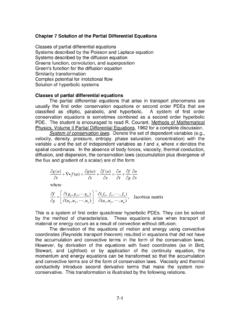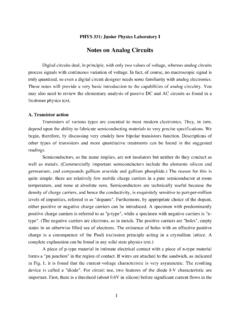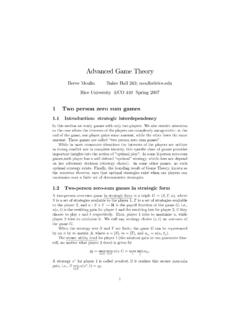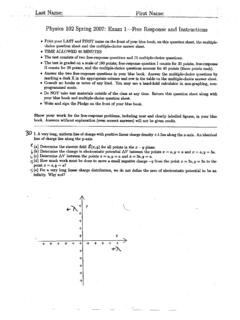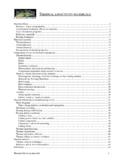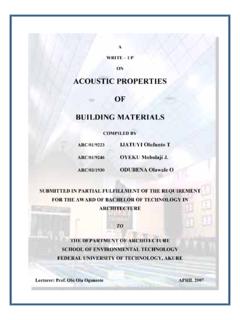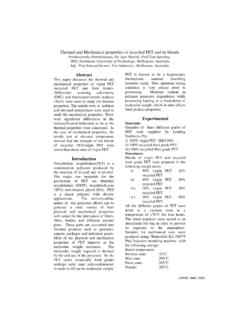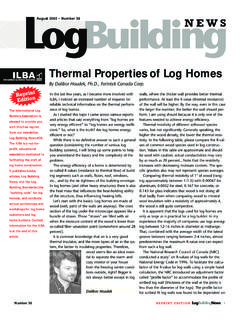Transcription of Chapter 2 Thermal Expansion - Rice University
1 THE COEFFICIENT OF LINEAR thermalexpansion (CTE, , or 1) is a material propertythat is indicative of the extent to which a mate-rial expands upon heating. Different substancesexpand by different amounts. Over small tem-perature ranges, the Thermal Expansion of uni-form linear objects is proportional to tempera-ture change. Thermal Expansion finds usefulapplication in bimetallic strips for the construc-tion of thermometers but can generate detrimen-tal internal stress when a structural part is heatedand kept at constant a more detailed discussion of thermalexpansion including theory and the effect ofcrystal symmetry, the reader is referred to theCINDAS Data Series on Material Properties,Volumes 1 to 4, Thermal Expansion of Solids(Ref 1).
2 DefinitionsMost solid materials expand upon heating andcontract when cooled. The change in length withtemperature for a solid material can be ex-pressed as:(lf l0)/l0= 1(Tf T0) l/l0= 1 T 1=1/l(dl/dT)where l0and lfrepresent, respectively, the origi-nal and final lengths with the temperaturechange from T0to Tf. The parameter 1 CTE andhas units of reciprocal temperature (K 1) such as m/m K or 10 6/K. Conversion factors are:To convertToMultiply by10 6/K10 6/ 6/ F10 6 C10 6/K110 6/ C10 6/K1( m/m)/ F10 6 ( m/m)/ C10 6/K110 6/R10 6 coefficient of Thermal Expansion is alsooften defined as the fractional increase in lengthper unit rise in temperature.
3 The exact definitionvaries, depending on whether it is specified at aprecise temperature (true coefficient of thermalexpansion or or over a temperature range(mean coefficient of Thermal Expansion or ).The true coefficient is related to the slope of thetangent of the length versus temperature plot,while the mean coefficient is governed by theslope of the chord between two points on thecurve. Variation in CTE values can occur ac-cording to the definition used. When is con-stant over the temperature range then = .Finite-element analysis (FEA) software such asNASTRAN (MSC Software) requires that beinput, not.)
4 Heating or cooling affects all the dimensionsof a body of material, with a resultant change involume. Volume changes may be determinedfrom: V/V0= V Twhere Vand V0are the volume change andoriginal volume, respectively, and Vrepresentsthe volume coefficient of Thermal Expansion . Inmany materials, the value of Vis anisotropic;that is, it depends on the crystallographic direc-tion along which it is measured. For materials inwhich the Thermal Expansion is isotropic, Visapproximately 3 determine the Thermal Expansion coeffi-cient, two physical quantities (displacement andtemperature) must be measured on a sample thatis undergoing a Thermal cycle.
5 Three of the maintechniques used for CTE measurement aredilatometry, interferometry, and thermomechani-cal analysis. Optical imaging can also be used atextreme temperatures. X-ray diffraction can beused to study changes in the lattice parameter butmay not correspond to bulk Thermal dilatometry tech-niques are widely used. With this technique, aspecimen is heated in a furnace and displace-ment of the ends of the specimen are transmittedto a sensor by means of push rods. The precisionof the test is lower than that of interferometry,and the test is generally applicable to materialswith CTE above 5 10 6/K ( 10 6/ F) overthe temperature range of 180 to 900 C ( 290to 1650 F).
6 Push rods may be of the vitreous sil-ica type, the high-purity alumina type, or theisotropic graphite type. Alumina systems can ex-tend the temperature range up to 1600 C(2900 F) and graphite systems up to 2500 C(4500 F). ASTM Test Method E 228 (Ref 2)cove the determination of linear Thermal expan-sion of rigid solid materials using vitreous silicapush rod or tube optical interferencetechniques, displacement of the specimen endsis measured in terms of the number of wave-lengths of monochromatic light. Precision is sig-nificantly greater than with dilatometry, but be-cause the technique relies on the opticalreflectance of the specimen surface, interferom-etry is not used much above 700 C (1290 F).
7 ASTM Test Method E 289 (Ref 3) provides astandard method for linear Thermal Expansion ofrigid solids with interferometry that is applicablefrom 150 to 700 C ( 240 to 1290 F) and ismore applicable to materials having low or neg-ative CTE in the range of <5 10 6/K ( 10 6/ F) or where only limited lengths of thick-ness of other higher Expansion coefficient mate-rials are analysismeasurementsare made with a thermomechanical analyzerconsisting of a specimen holder and a probe thattransmits changes in length to a transducer thattranslates movements of the probe into an elec-trical signal.
8 The apparatus also consists of afurnace for uniform heating, a temperature-sens-ing element, calipers, and a means of recordingresults. ASTM Test Method E 831 (Ref 4)describes the standard test method for linearthermal Expansion of solid materials by thermo-mechanical analysis. The lower limit for CTEwith this method is 5 10 6/K ( 10 6/ F),but it may be used at lower or negative expan-sion levels with decreased accuracy and preci-sion. The applicable temperature range is 120 Chapter 2 Thermal Expansionto 600 C ( 185 to 1110 F), but the temperaturerange may be extended depending on instrumen-tation and calibration ConsiderationsWith respect to temperature, the magnitude ofthe CTE increases with rising Expansion of pure metals has been wellcharacterized up to their melting points, but datafor engineering alloys at very high temperaturesmay be limited.
9 In general, CTE values for met-als fall between those of ceramics (lower values)and polymers (higher values). Common valuesfor metals and alloys are in the range of 10 to 30 10 6/K ( to 10 6/ F). The lowestexpansion is found in the iron-nickel alloys suchas Invar. Increasing Expansion occurs with sili-con, tungsten, titanium, silver, iron, nickel, steel,gold, copper, tin, magnesium, aluminum, zinc,lead, potassium, sodium, and alloysare materials with di-mensions that do not change appreciably withtemperature. Alloys included in this category arevarious binary iron-nickel alloys and several ter-nary alloys of iron combined with nickel-chromium, nickel-cobalt, or cobalt-chromiumalloying.
10 Low- Expansion alloys are used in ap-plications such as rods and tapes for geodeticsurveying, compensating pendulums and bal-ance wheels for clocks and watches, movingparts that require control of Expansion (such aspistons for some internal-combustion engines),bimetal strip, glass-to-metal seals, thermostaticstrip, vessels and piping for storage and trans-portation of liquefied natural gas, superconduct-ing systems in power transmissions, integrated-circuit lead frames, components for radios andother electronic devices, and structural compo-nents in optical and laser measuring and Aluminum di-mensional change of aluminum and its alloyswith a change of temperature is roughly twicethat of the ferrous metals.
